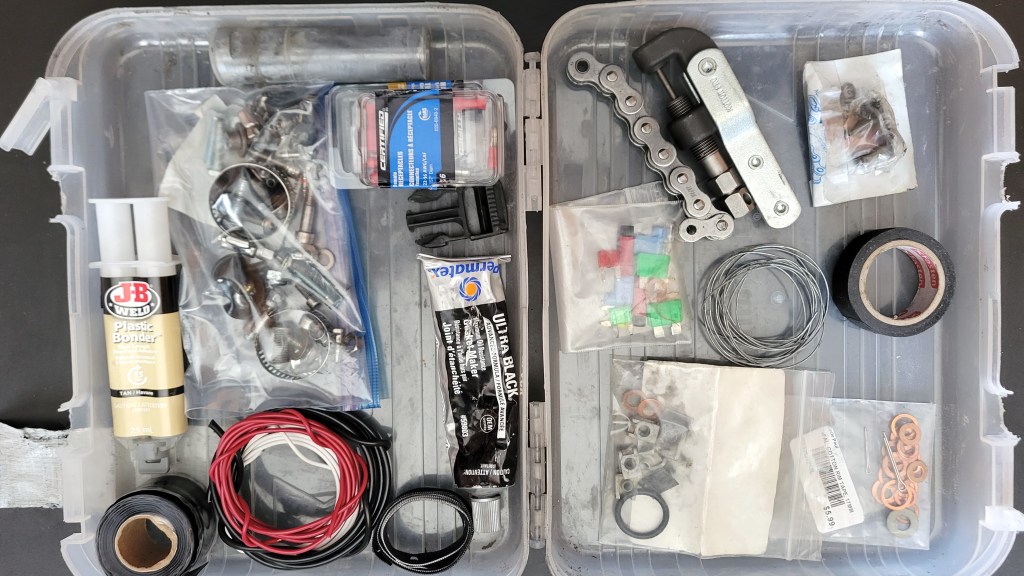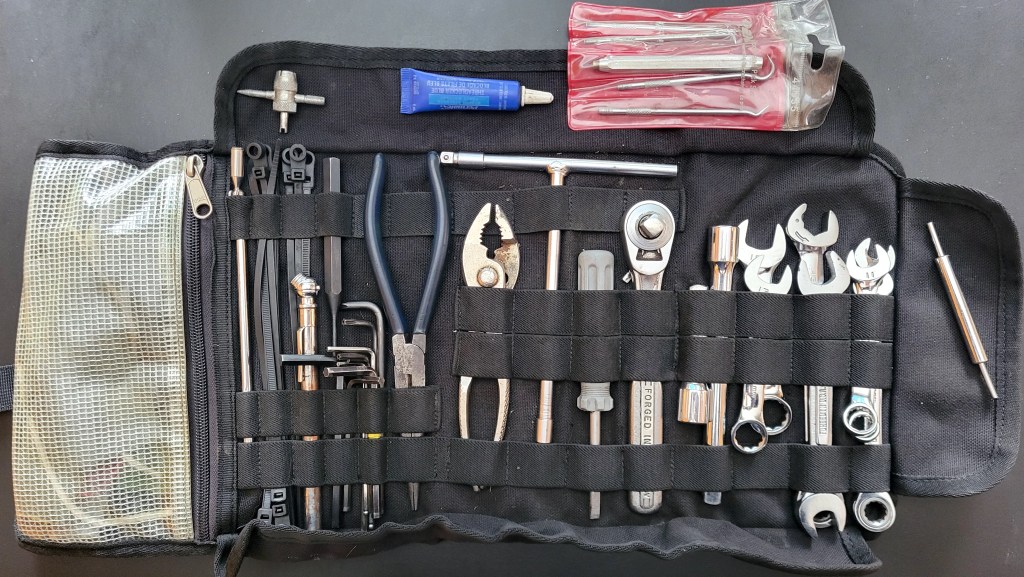In the penultimate post in a series on gear, I discuss what I carry when touring.

The first major tour I did was to Cape Breton to ride the Cabot Trail. As you cross the border from New Brunswick to Nova Scotia, heading east, you see at the side of the highway a mini-lighthouse advertising Tourist Information. I naturally pulled off for maps and a rest. In the parking lot, I noticed a burley, bearded, rider on his back beneath his Harley, trying to tighten an oil filter with a pair of pliers.
“Hey, can I help in some way?,” I offered. None of his fellow riders seemed either able or willing.
“Not unless you have a 14mm socket,” was the reply that emanated from beneath the bike.
I rummaged to the bottom of a pannier and emerged with the requested item.
“Here you go,” I said, and handed it down to him.
Every touring group should include at least one ADV rider. Because we venture into remote areas, we have to be self-sufficient, and that means being prepared for anything. Anything. Mechanical problems, medical emergencies, security issues—we need to carry on the bike into the bush the tools, spare parts, first-aid materials, and safety items required to get us back out of the bush.
The basis of my touring kit is my tool roll. I use the Kriega roll because I like the little pouch at the side for all the odds and ends that don’t fit anywhere else.

That includes an assortment of hardware and fuses, pipe cleaners, emery paper, safety wire, thread lock, a valve stem tool, picks, and a tool for removing pins from electrical connectors (viewed far right above). The latter contains two tubes of different diameters, one on each end; hopefully one is the perfect diameter to slide over the pin but inside the hole in the connector. The tool pushes the barbs of the pin in so the wire can be extracted out the back of the connector.
I once had a flasher that had a break in the wire inside the connector plug, so I couldn’t simply splice the wire. Every time I put on the flasher, I’d blow the fuse to the circuit that included my dash, so no speedometer, tachometer, and other instrumentation. The only way to fix it, other than getting a new connector and splicing wires, was to remove the pin from the connector using a tool like this. Since then, it’s become part of my toolkit.
Left to right above in my roll is a telescopic magnet, zip ties, various Allen keys particular to my bike, needle-nose pliers, slip-joint pliers, a 1/4″ T-handle, reversible screwdriver (standard/Phillips), 3/8″ ratchet, socket extensions, various wrenches. I like the stubby wrenches from Home Depot because they are lighter—not as light as titanium wrenches, but my wallet is heavier for it. I indulge myself with a ratcheting 10mm wrench.
Why the 1/4″ T-handle? Some of those sockets are 1/4″, but with the Motion Pro T6 adapter, I can use all my 3/8″ sockets on the T-handle.
Where are the vice-grips, you ask? They are in my other tool kit since they don’t fit in this one. As I’ve said elsewhere, I don’t use vice-grips very often when working, but they are handy in a pinch, so to speak (sorry).

In a Dollar Store pencil case, I have my sockets, some hex bit sockets (3/8″ and 1/4″ stubbies), an elbow socket, spark plug socket, a couple of crowfoot sockets (again, particular to my bike), a spoke wrench, and said vice grips (aka locking pliers). I used to carry torx bits with the BMW, but since switching to Triumph, I now carry hex bits.
There’s some redundancy here, for sure. I probably don’t need both Allen keys and Allen sockets, but the keys don’t take up much space, and sometimes one tool is better than the other for a particular purpose.
I also carry:
- Tubes. I know you can get by with one, the front, and cram it into the rear if needed, but I carry both a front and rear tube.
- A chain breaker, spare links, and a master clip. I like the Motion Pro Chain breaker for on the road. It doesn’t do rivets like the DID one does, so I have both. I use the DID at home when changing my chain, but take the smaller Motion Pro one on the road with a clip master link.
- A digital multimeter for troubleshooting electrical problems. Don’t ask me how to use it beyond the basics because I’m still learning The Dark Arts, but I take one nonetheless. I have the Neoteck NT8233D Pro, which is cheap enough to get wrecked while ADV riding but still decent enough quality and reasonable in size. I’ve considered getting a smart meter, but wondered if it would be reliable enough. Anyone have any experience with these?
- An Arteck battery jumper.

Tools, sockets, tubes, multimeter, and chain tool all go in Giant Loop Possibles Pouches that attach to my crash bars at the front, helping to keep the bike balanced front to back.
In one of my panniers, I carry a plastic box that contains other items and spare parts (see image at top). The spare parts have gone with the sold BMW so need to be replenished, but they were a spare clutch cable, spare levers, and a spare water pump. If I were doing a RTW tour, I’d carry more spare parts than this, but so far my tours have been in North America, where parts are readily available.
Also in that container:
- JB Weld Steel Stick, for fixing engine casing.
- JB Weld Plastic bonder. I’ve use this to fix body panels and broken mirrors.
- Self-sealing tape. This stuff is amazing and can seal a high-pressure hose.
- High-temperature electrical tape for wrapping electrical wires.
- An assortment of electrical connectors, including Posi-Lock, and heat shrink.
- More hardware, more fuses, assorted copper crush washers, cotter pins, O-rings, velcro.
- Various gauge wire
- Gasket maker
- An extra buckle for my Wolfman tank bag.
Finally, to round out my emergency preparedness, I carry a first-aid kit and bear spray. The kit I put together myself. I took a look at what you get in those prepared kits and it didn’t look like much for the cost, so I bought another trusty Dollar Store pencil case and filled it myself. I won’t go through all that I have in there, but will say the few things you won’t get in those commercial kits:
- Carbon capsules. Eaten something that doesn’t agree with you? Take two, wait half an hour, take a dump, job done.
- Arnica Montana. Homeopathy for any trauma to the body.
- Robax. I have a vulnerable back, which tends to go at the most unexpected times.
- Antihistamines. These are great for any inflammation from bee stings or allergic reactions.
- Triple Action Polysporin
These items, along with the essentials I always carry on the bike, round out my touring kit. They say an ounce of prevention is worth a pound of cure, and all this stuff adds up to a quite a few pounds, so I think I’m covered. The challenge is always to find the right balance between taking what you need while keeping the weight down. I’d rather sacrifice some creature comforts like a camp chair, but I rarely sacrifice when it comes to tools and other items needed to keep the bike running (although the camp chair would come in handy if stranded in the middle of nowhere).
I’ll add one more item this winter to my tools: a satellite communicator. I’ve been meaning to get one for a while, and it really is silly to travel into remote areas without one. I’ve considered them all and almost bought a Garmin inReach Mini, but I’m leaning toward getting a Zoleo at half the price. Any thoughts, anyone? I don’t see what the Garmin does that the Zoleo cannot. Am I missing something?
Have I missed anything in my touring kit? As always, your kit is personal to you, so let me know in a comment if there’s something you carry that I do not. Like I said, I’m a self-confessed gear weanie, so I’m always interested in learning about a tool I have to buy. Buying gear is one of the ways we riders in the North get through the off-season, and yesterday I put the Tiger into storage, so I’m all ears.
I’ll wrap up this series in my next post on the navigation apps I use. If that interests you, click Follow and you’ll be notified of it and future posts when they are published.
Looks like there’s a satellite communicator on your Christmas List. Talk to Abe or Julian. They have one they share and they’ve used it while interior camping mostly for texting that all is well but it’s nice to know they have it with them when in remote areas. I’m sure they could advise and suggest some good options
LikeLiked by 1 person
Thanks, will do.
LikeLike
Hey.
Thank you for keeping us connected.
I really like your blog. If you retire soon you can publish more often?
Do you take a laptop travelling?
Do you think CBD oil instead of robaxocet would be problematic travelling?
Cheers from BC
LikeLiked by 1 person
Yes, absolutely, when I retire I’ll have more time for everything, including riding. I’ve got big plans for this blog and maybe a YouTube channel. The latter will be a big investment but I might start small next summer with a single camera.
I don’t take a laptop with me. That might have to change. But at the moment, I take a digital recorder and good ol’ pen and notebook, and I’m blessed with a good memory. All the writing takes place at my desk once home.
I’ve never tried CBD oil so can’t comment on that. If it affects judgment, then yes, it probably would be problematic. But lately the back has been okay. I started working with a new trainer and the exercises he has given me seem to be working. I will have to do more stretching when touring. Hey, maybe there’s a blog post there to be written!
Thanks for commenting.
LikeLike
One more question Sir:
When you travelled across the country, how often did you change the engine oil?
Fred
LikeLike
I changed it twice, about every 7,000 K—once in Vancouver North (after crossing the country and doing Vancouver Island), and once in Whitehorse after touring up north, before heading back.
LikeLike